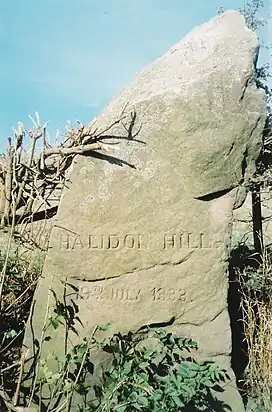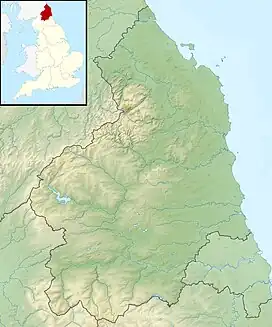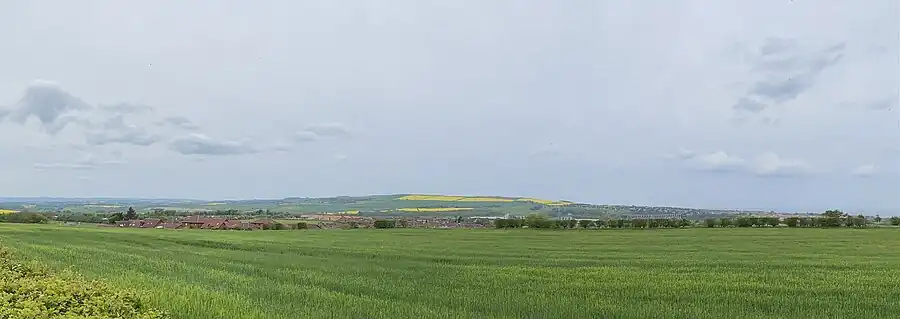Halidon Hill
Halidon Hill is a summit, about 2 miles (3 km) west of the centre of Berwick-upon-Tweed, on the border of England and Scotland. It reaches 600 feet (180 m) high. The name of the hill indicates that it once had a fortification on its top. It is bounded by the A6105 road on its south and the A1 road to the northeast.
| Halidon Hill | |
|---|---|
 Battle of Halidon Hill cairn | |
| Highest point | |
| Elevation | 163 m (535 ft) |
| Coordinates | 55.787°N 2.052°W |
| Geography | |
 Halidon Hill | |
| OS grid | NT968548 |
History
At the Battle of Halidon Hill in 1333, Edward III of England used longbowmen on the heights of the hill to defeat the Scottish army led by Archibald the "Tyneman" Douglas, Regent of Scotland.
An English army camped at Halidon Hill on 27 March 1560. The soldiers were sent into Scotland to help at the siege of Leith during the Scottish Reformation.[1] Mary, Queen of Scots came to Halidon Hill to view Berwick on 15 November 1566 and met John Foster, Marshal of Berwick.[2]
When James VI visited Halidon Hill near on 27 April 1588 there was a cannon salute and he spoke with members of the garrison. He gave the English commanding officers a gift of 100 gold crowns and to the porters (officers of lesser rank) 40 crowns described as "drinksilver".[3]
In April 1595, James VI and Anne of Denmark planned to come on a progress towards Berwick including a visit to Halidon Hill which overlooked the town and its fortifications. The governor of Berwick, Henry Carey, 1st Baron Hunsdon wondered if the town should give them a cannon salute.[4] James and Anne planned a similar trip, from Spott, in April 1597.[5]
See also
References
- HMC Manuscripts of Lord Montagu of Beaulieu (London, 1900), p. 8.
- Thomas Thomson, James Melville, Memoirs of his own life (Edinburgh, 1827), p. 173.
- David Moysie, Memoirs of the Affairs of Scotland (Edinburgh, 1755), p. 135.
- HMC Salisbury Hatfield, vol. 5 (London, 1894), p. 192: William Acres, Letters of Lord Burleigh to his son Robert Cecil (Cambridge, 2017), p. 171.
- Joseph Bain, Calendar of Border Papers, vol. 2 (Edinburgh, 1896), p. 292 no. 583.
External links
- English Heritage: Battle of Halidon Hill
- GOOGLE book: "Halidon hill: a dramatic sketch from Scottish history" by Sir Walter Scott
